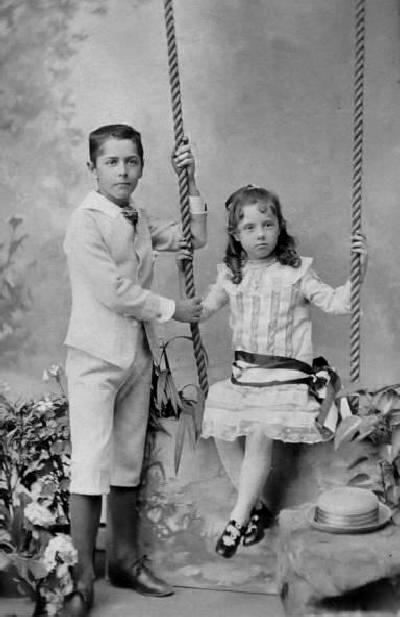
Long Stockings: Colors--Chronology

Figure 1.--Here we see a St. Louis brother and sister who had their portrait taken in summer outfits during 1887. The obvious problem in assessing the colors of long stockings over time is that most of the photographs are black and white. We hgave no idea what color the boys stockings here were.
|
|
The colors of long stockings varied over time. The pattern varied somewhat from country to country, but therecare some similar trends. We note many children wearing long white stockings in the mid-19th century. This seems especially common in America. We also note striped stockings as well as stockings done in various colors. By the late 19th century black long stockings were dominant, especially in America. After the turn of the century boys began to wear white stockings with a variety of outfits, including tunic suits, Buster Brown suits, sailor suits, and Fauntleroy suits--but the dark colors were still more common. As long stockings declined in popularity during the 1920s, lighter, natural colors became more popular--flat tones like tan, dark tan, brownstone, and suntan. These light colors were meant to look more like flesh tones. We still note these flesh tones like beige being worn into the 1960s. A good example is two Soviet boys. Dressy stockings were also available in white. Long stockings were never made in bright colors.
The 19th Century
We note many children wearing long white stockings in the mid-19th century. We are not sure jow long they were, but white stockings were quite common. A good example is American boy John Van Horn in 1859. This seems to have been quite common in the 1860s when knee pants were beginning to become increasingly common. This seems especially common in America. We also note striped stockings. It is impossible to know much about the colors of the stripes. We also note stockings done in various colors, including red. Many mothers selected stocking colors to match the boys suits. By the late 19th century black long stockings were dominant, especially in America. At the turn of the century approached we see children wearing black long stockinf with white or other light-colored outfits, contrasting rather than matching.
The 20th Century
After the turn of the century boys began to wear white stockings with a variety of outfits, including tunic suits, Buster Brown suits, sailor suits, and Fauntleroy suits--but the dark colors were still more common. We do not see many boys wearing white long stockings by the 1930s. There are still some boys whob wore them. One of the latest examples is a German boy in 1930. And we see a few American boys still wearing them, again for First Communion. As long stockings declined in popularity during the 1920s, lighter, natural colors became more popular--flat tones like tan, dark tan, brownstone, and suntan. These light colors were meant to look more like flesh tones. We still note these flesh tones like beige being worn into the 1960s. A good example is two Soviet boys. Dressy stockings were also available in white. Long stockings were never made in bright colors.
HBC

Related HBC Pages:
[Return to the main Main long stocking color page]
[Knee socks]
[White knee socks]
[Long stockings]
[Striped socks]
[White stockings]
[Tights]
Navigate the Historic Boys' Clothing Web Site:
[Introduction]
[Activities]
[Biographies]
[Chronologies]
[Countries]
[Style Index]
[Bibliographies]
[Contributions]
[FAQs]
[Glossaries]
[Images]
[Registration]
[Tools]
[Boys' Clothing Home]
Created: 11:05 PM 4/22/2007
Last updated: 11:05 PM 4/22/2007



